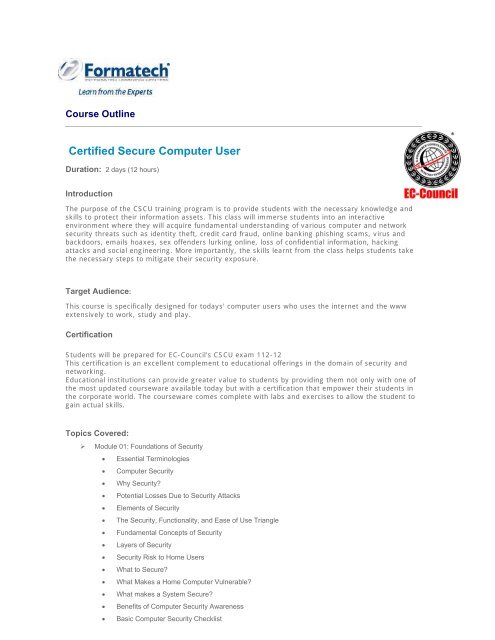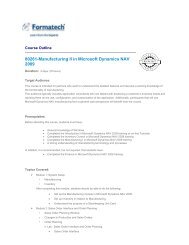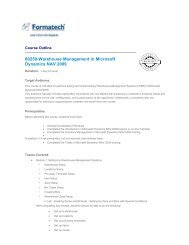Certified Secure Computer User.pdf - Formatech
Certified Secure Computer User.pdf - Formatech
Certified Secure Computer User.pdf - Formatech
- No tags were found...
Create successful ePaper yourself
Turn your PDF publications into a flip-book with our unique Google optimized e-Paper software.
Course Outline<strong>Certified</strong> <strong>Secure</strong> <strong>Computer</strong> <strong>User</strong>Duration: 2 days (12 hours)IntroductionThe purpose of the CSCU training program is to provide students with the necessary knowledge andskills to protect their information assets. This class will immerse students into an interactiveenvironment where they will acquire fundamental understanding of various computer and networksecurity threats such as identity theft, credit card fraud, online banking phishing scams, virus andbackdoors, emails hoaxes, sex offenders lurking online, loss of confidential information, hackingattacks and social engineering. More importantly, the skills learnt from the class helps students takethe necessary steps to mitigate their security exposure.Target Audience:This course is specifically designed for todays' computer users who uses the internet and the wwwextensively to work, study and play.CertificationStudents will be prepared for EC-Council's CSCU exam 112-12This certification is an excellent complement to educational offerings in the domain of security andnetworking.Educational institutions can provide greater value to students by providing them not only with one ofthe most updated courseware available today but with a certification that empower their students inthe corporate world. The courseware comes complete with labs and exercises to allow the student togain actual skills.Topics Covered:‣ Module 01: Foundations of Security Essential Terminologies <strong>Computer</strong> Security Why Security? Potential Losses Due to Security Attacks Elements of Security The Security, Functionality, and Ease of Use Triangle Fundamental Concepts of Security Layers of Security Security Risk to Home <strong>User</strong>s What to <strong>Secure</strong>? What Makes a Home <strong>Computer</strong> Vulnerable? What makes a System <strong>Secure</strong>? Benefits of <strong>Computer</strong> Security Awareness Basic <strong>Computer</strong> Security Checklist
‣ Module 02: Securing Operating Systems System Security Threats to System Security Password Cracking Guidelines for Windows OS Security Lock the System When Not in Use Create a Strong <strong>User</strong> Password Change Windows <strong>User</strong> Password: Windows 7 Disable the Guest Account: Windows 7 Lock Out Unwanted Guests in Windows 7 Rename the Administrator Account in Windows 7 Disable Start up Menu in Windows 7 Windows Updates in Windows 7 Pointers for Updates Apply Software Security Patches Configuring Windows Firewall in Windows 7 Adding New Programs in Windows Firewall in Windows 7 Removing/Disabling Programs Rules from the Windows Firewall in Windows 7 Creating a New Windows Firewall Rule in Windows 7 Two-Way Firewall Protection in Windows Always Use NTFS Windows Encrypting File System (EFS) How to Decrypt a File Using EFS in Windows? Using Windows Defender Enable BitLocker in Windows 7 Launching Event Viewer in Windows 7 Event Viewer: Events and How to Read Logs on the System Disabling Unnecessary Services in Windows 7 Killing Unwanted Processes Finding Open Ports Using Netstat Tool Configuring Audit Policy How to Hide Files and Folders? Disable Simple File Sharing in Windows Raise the UAC Slider Bar in Windows 7 Windows Security Tools Windows Security Tools: Microsoft Security Essentials Windows Security Tools: KeePass Password Safe Portable Windows Security Tools: Registry Mechanic Guidelines for Securing Mac OS X Step 1: Enabling and Locking Down the Login Window Step 2: Configuring Accounts Preferences Step 3: Guidelines for Creating Accounts Step 4: Securing the Guest Account Step 5: Controlling Local Accounts with Parental Controls Step 6: Use Keychain Settings Step 7: Use Apple Software Update
Step 8: Securing Date & Time Preferences Step 9: Securing Network Preferences Step 10: Enable Screen Saver Password Step 11: Set Up FileVault to Keep Home Folder <strong>Secure</strong> Step 12: Firewall Security Operating Systems Security Checklist Security Checklist for Windows 7 MAC OS Security Checklist‣ Module 03: Protecting System Using Antiviruses Introduction to Antivirus Software Need for Antivirus Program How Does Antivirus Software Work? Antivirus Software 2011 Choosing the Best Antivirus Software Steps to Install Antivirus on Your <strong>Computer</strong> How to Test If Antivirus Is Working Configuring McAfee Antivirus Configuring Kaspersky PURE Antivirus Security Checklist‣ Module 04: Data Encryption Common Terminologies What is Encryption? Objectives of Encryption Usage of Encryption Types of Encryption Symmetric vs. Asymmetric Encryption Encryption Standards Digital Certificates How Digital Certificates Work? Digital Signature Cryptography Tools‣ Module 05: Data Backup and Disaster Recovery Data Backup Need for Backup Types of Data Loss What Files to Backup and How Often? Online Data Backup Online Backup Service Providers Types of Backup Back Up the Data Using Windows Backup Steps to Backup Data Restoring Data Securing Backup on Storage Devices with Encryption Time Machine (Apple Software) Setting Up Time Machine Restoring Files from Time Machine Backups Data Backup Tools for Windows
Acronis True Image Home 2011 NovaBACKUP Home Protection Data Backup Tools for Windows Data Backup Tools for MAC OS X MAC OS X Data Backup Tool: Data Backup MAC OS X Data Backup Tool: SmartBackup Data Backup Tools for MAC OS X Data Recovery Tools for Windows Windows Data Recovery Tool: Recover My Files Windows Data Recovery Tool: EASEUS Data Recovery Wizard Data Recovery Tools for Windows MAC OS X Data Recovery Tool Boomerang Data Recovery Software VirtualLab Data Recovery Tools for MAC OS X Physical Security Physical Security Measures: Locks Physical Security Measures: Biometrics Physical Security Measures: Fire Prevention Physical Security Measures: HVAC Considerations Securing Laptops from Theft Laptop Theft Countermeasures Data Backup Checklist Physical Security Checklist‣ Module 06: Internet Security Internet Security Internet Explorer Security Settings Internet Explorer Security Settings: Internet Zone Internet Explorer Security Settings: ActiveX Controls Internet Explorer Security Settings: Local Intranet Zone Internet Explorer Security Settings: Trusted Sites Zone Internet Explorer Security Settings: Restricted Zone Understanding Cookies Internet Explorer Privacy Settings Deleting Browsing History Do Not Allow the Browser to Remember any Password Securing File Downloads Mozilla Firefox Security Settings Mozilla Firefox: Privacy Settings Securing File Downloads Installing Plugins Google Chrome Privacy and Security Settings Google Chrome: Privacy Settings Google Chrome: Security Settings Apple Safari Security Settings Testing the Browser for Privacy Instant Messaging (IMing)
Instant Messaging Security Issues Instant Messaging Security MeasuresSearching the WebOnline Gaming and MMORPG Online Gaming Risks Insecure or Compromised Game Servers and Game Coding Social Risks Social EngineeringProtection Schemes, Cyber Prostitution, and Virtual MuggingHow the Malicious <strong>User</strong>s Make Money?Security Practices Specific to Gaming Recognize Administrator Mode Risks Recognize Risks due to ActiveX and JavaScript Play the Game, Only at the Game Site Pay Attention to Firewall ManagementChild Online Safety Risks Involved OnlineMisdirected SearchesStealth Sites and Misleading URLsChild Pornography, Grooming, and CyberbullyingRole of Internet in Child Pornography Effects of Pornography on Children Risks Involved in Social Networking WebsitesUnsolicited EmailsChat RoomsFinding if Children are at Risk OnlineProtecting Children from Online ThreatsEncourage Children to ReportHow to Report a Crime?Security Software Checklist KidZuiActions to Take When the Child Becomes an Online VictimInternet lawsLaws Internet users should know USA PATRIOT Act Children’s Online Privacy Protection Act (COPPA) The Digital Millennium Copyright ActHighlights of DMCA CAN-SPAM Act <strong>Computer</strong> Misuse Act 1990 European Union Data Protection Directive (95/46/EC) Data Protection Act 1998Internet Security ChecklistGuidelines for Parents to Protect Children from Online ThreatsModule 07: Securing Network ConnectionsHome Network Network Devices
Steps for Home Networking Wireless Networks Setting Up a Wireless Network in Windows 7 Changing Wireless Networking Configuration in Windows 7 Setting Up a Wireless Network in Mac Changing Wireless Networking Configuration in Mac Common Threats to Wireless Network Securing Wireless Network Using the Network with Windows 7 Setting Up the PC’s Name and Workgroup Name in Windows 7 Sharing Transferring Files Simple File Sharing in Windows 7 Hiding a Shared Disk or Folder How to Share Printer in Windows 7? Using Printers on Other PC’s Accessing Files on Other PCs Windows Easy Transfer Using the Network with MAC OS X Setting Up the PC’s Name in MAC OS X Setting Up the Workgroup Name in MAC OS X Creating <strong>User</strong> Accounts and Groups in MAC OS X Sharing Files and Folders in Macintosh OS X Printer Sharing in Macintosh OS X Accessing Other Macs on Your Network Network Security Threats Securing Network Connections Use Firewall Use Antivirus Protection Use Strong Passwords, Make Regular Backups, and Know about Encryption Identify a <strong>Secure</strong> Website General Security Practices in Home Networking Network Adapters Checking Network Adapter Network Setup Wizard How to Isolate Networking Problems (Windows 7): Network Adapter? Network Adapter Status Troubleshooting with Network Adapters Network Adapter is Unplugged Network Adapter Has Limited or No Connectivity Network Adapter is Connected, but <strong>User</strong> Cannot Reach the Internet Network Security Checklist Module 08: Securing Online Transactions Online ShoppingOnline BankingHow Online Shopping Works?Credit Cards Payments
Types of Credit Card FraudsGuidelines for Ensuring Credit Card SafetySecuring Online TransactionsOnline Payment Services Choosing a <strong>Secure</strong> Online Payment ServiceSSL and the Padlock Symbol What Does the SSL Show?Identifying a Trustworthy WebsiteIdentifying an Untrustworthy WebsiteMcAfee’s Site Advisor Rating IconsOnline Transactions Security Checklist Module 09: Securing Email Communications Email SecurityEmail Security Threats Malicious Email AttachmentsEmail Attachments: Caution SpammingSpamming Countermeasures Anti-Spamming Tool Hoax/Chain Emails Scam EmailsNigerian ScamEmail Security Procedures Creating Strong Passwords Alternate Email Address Keep Me Signed In/Remember Me Using HTTPS Check for Last Account Activity Scanning Email Attachments Turn Off Preview Feature Email Filtering: Avoiding Unwanted Emails Digitally Sign Your EmailsHow to Obtain Digital Certificates?Installing Digital CertificateSigning your Emails Microsoft Outlook Download SettingsOnline Email Encryption ServiceEmail Security ToolsEmail Communication ChecklistEmail Security ChecklistSecurity Checklist for Checking Emails on Mobile Module 10: Social Engineering and Identity Theft What Is Identity Theft?Personal Information that Can be Stolen
How Do Attackers Steal Identity?What Do Attackers Do with Stolen Identity?Identity Theft ExampleSocial Engineering Social Engineering Examples Human-Based Social Engineering <strong>Computer</strong>-Based Social Engineering<strong>Computer</strong>-Based Social Engineering: PhishingPhony Security Alerts <strong>Computer</strong>-based Social Engineering Through Social Networking WebsitesHow to Learn if You Are a Victim of Identity TheftWhat to Do if Identity Is StolenReporting Identity Theft Federal Trade Commission econsumer.gov Internet Crime Complaint CenterProsecuting Identity TheftProtecting from Identity Theft IP Address Hiding ToolsIdentity Theft Protection Checklist<strong>Computer</strong> Based Identity Theft Protection Checklist Module 11: Security on Social Networking Sites Social Networking SitesWhat Is a Profile?Top Social Networking SitesSecurity Risks Involved in Social Networking Sites Cyberbullying Identity Theft Phishing Scams Malware Attacks Site FlawsSocial Networking Threats to MinorsFacebook Privacy Settings Profile Settings Privacy Settings for Applications Settings to Block <strong>User</strong>s Recommended Actions for Facebook Search Settings Facebook: Security TipsStaying Safe on MySpaceSocial Networking Security ChecklistSocial Networking Security Checklist for Parents and Teachers Module 12: Information Security and Legal Compliance HIPPAFERPAHIPPA Checklist
FERPA ChecklistPCI DSS PCI DSS Checklist Module 13: Securing Mobile Devices Mobile Device SecurityMobile Phone ServicesIMEI NumberMobile Device Security Risks Mobile Malware Mobile Application VulnerabilitiesThreats to Bluetooth DevicesMobile Security Procedures Patching Mobile Platforms and Applications Avoid Mobile Device Theft What to DO if Your Mobile is Lost or Stolen Use Power-On Authentication Regularly Back Up Important Data Use Encryption to <strong>Secure</strong> Data in Mobile Device Enable the Auto-Lock Feature Install Only Signed Applications Install Mobile Phone Anti-Virus Mobile Phone Anti-Virus Tools <strong>Secure</strong> Bluetooth ConnectivitySecuring iPhone and iPad Enable Passcode Protection Enable SIM PIN Protection Enable Auto-Lock and Re-map Button iPad SecuritySecuring Blackberry and Windows Phone 7 Mobiles BlackBerry: Setting Device Password BlackBerry: Changing the Device Password BlackBerry: Lock Your Device BlackBerry: Device Password BlackBerry Password Keeper Encrypting Data on Your BlackBerry Device Windows Phone 7 Mobiles: Use of PIN to Lock SIM Card Windows Phone 7 Mobiles: Changing the Password of the PhoneMobile Security ToolsBluetooth Security ChecklistMobile Phone Security Checklist





